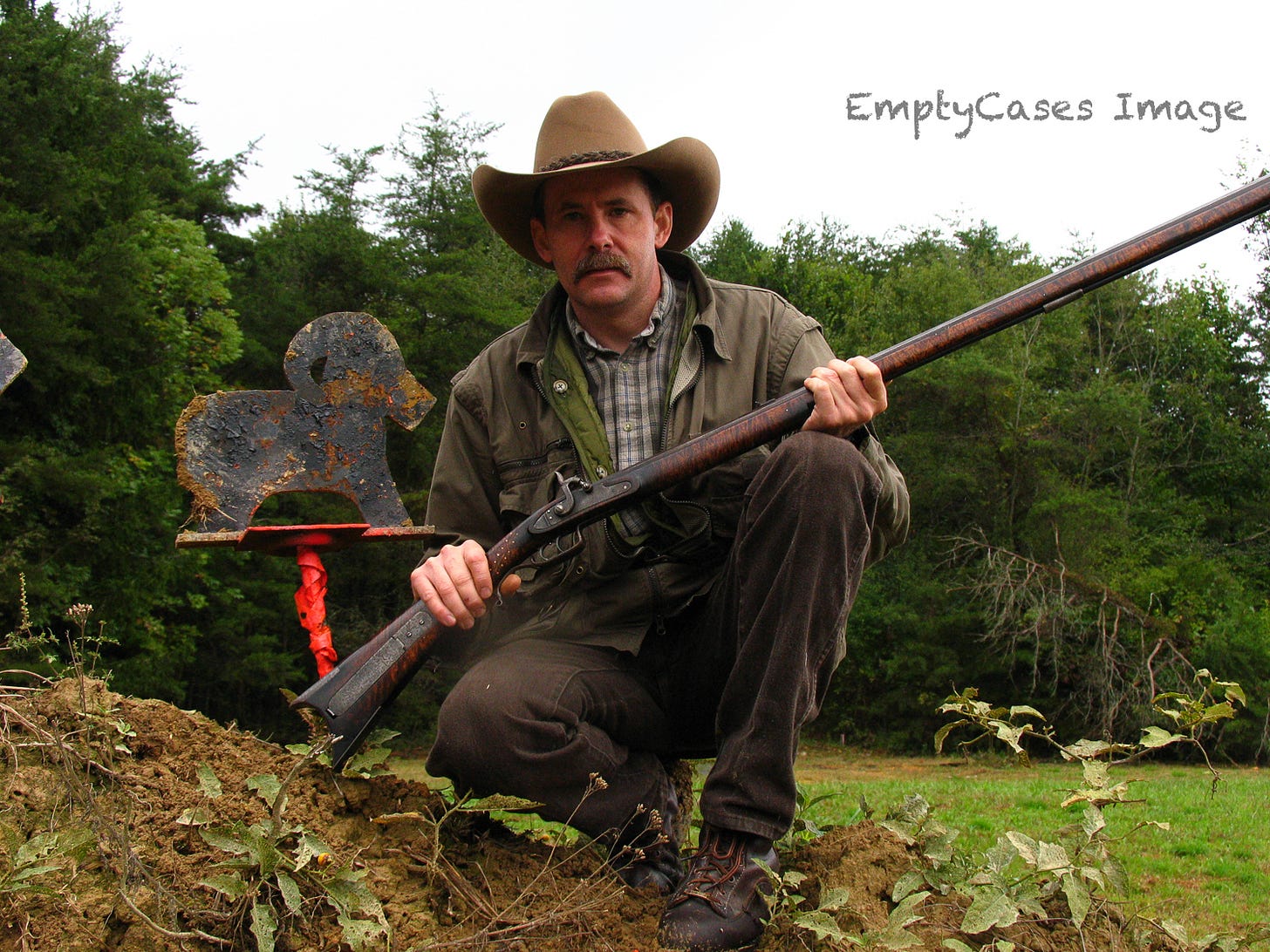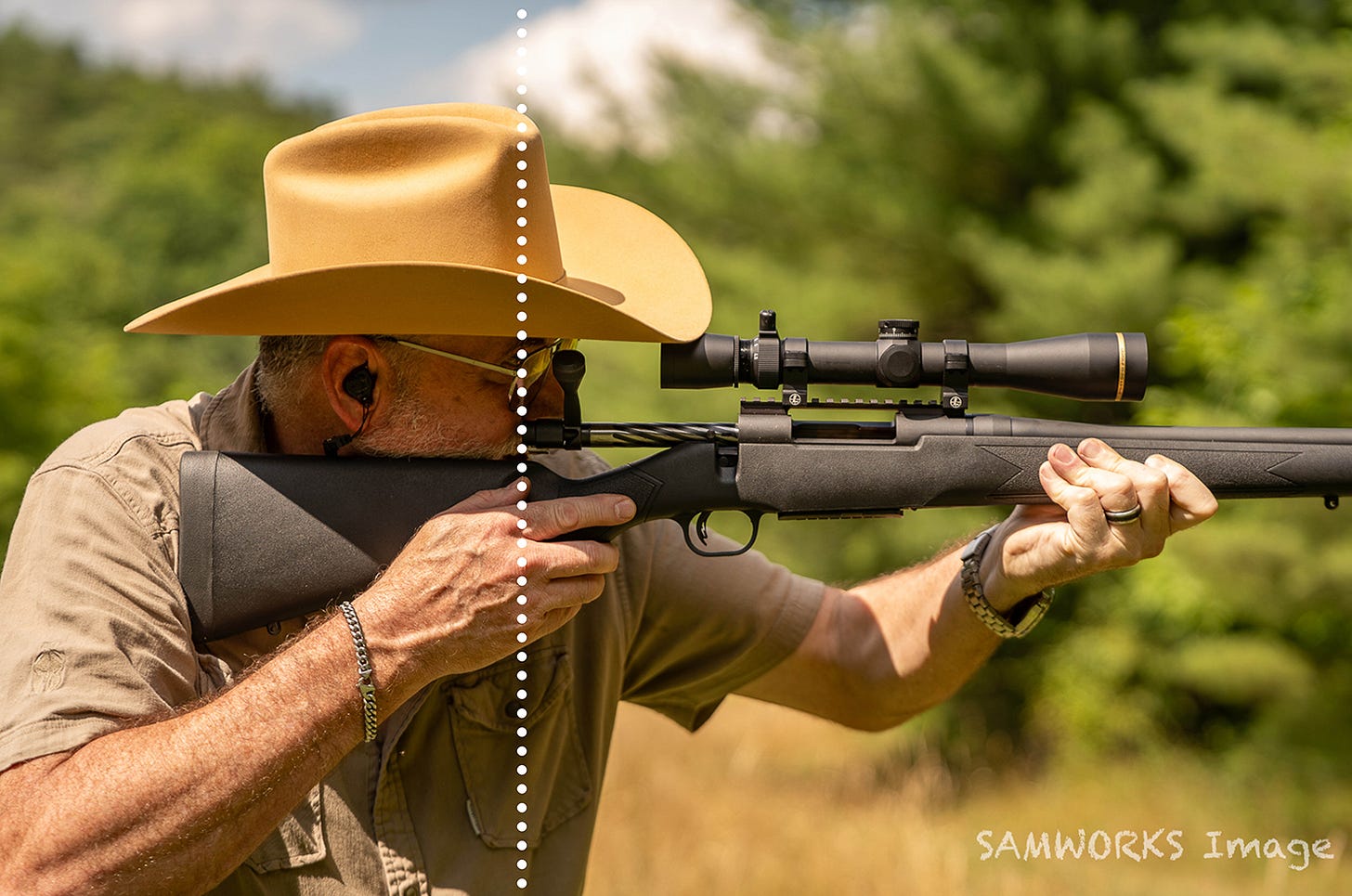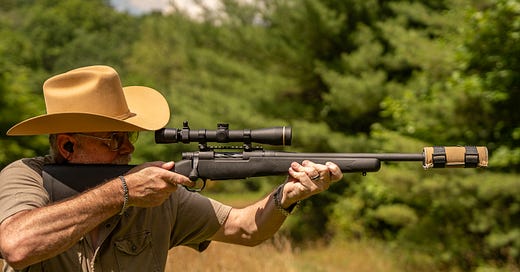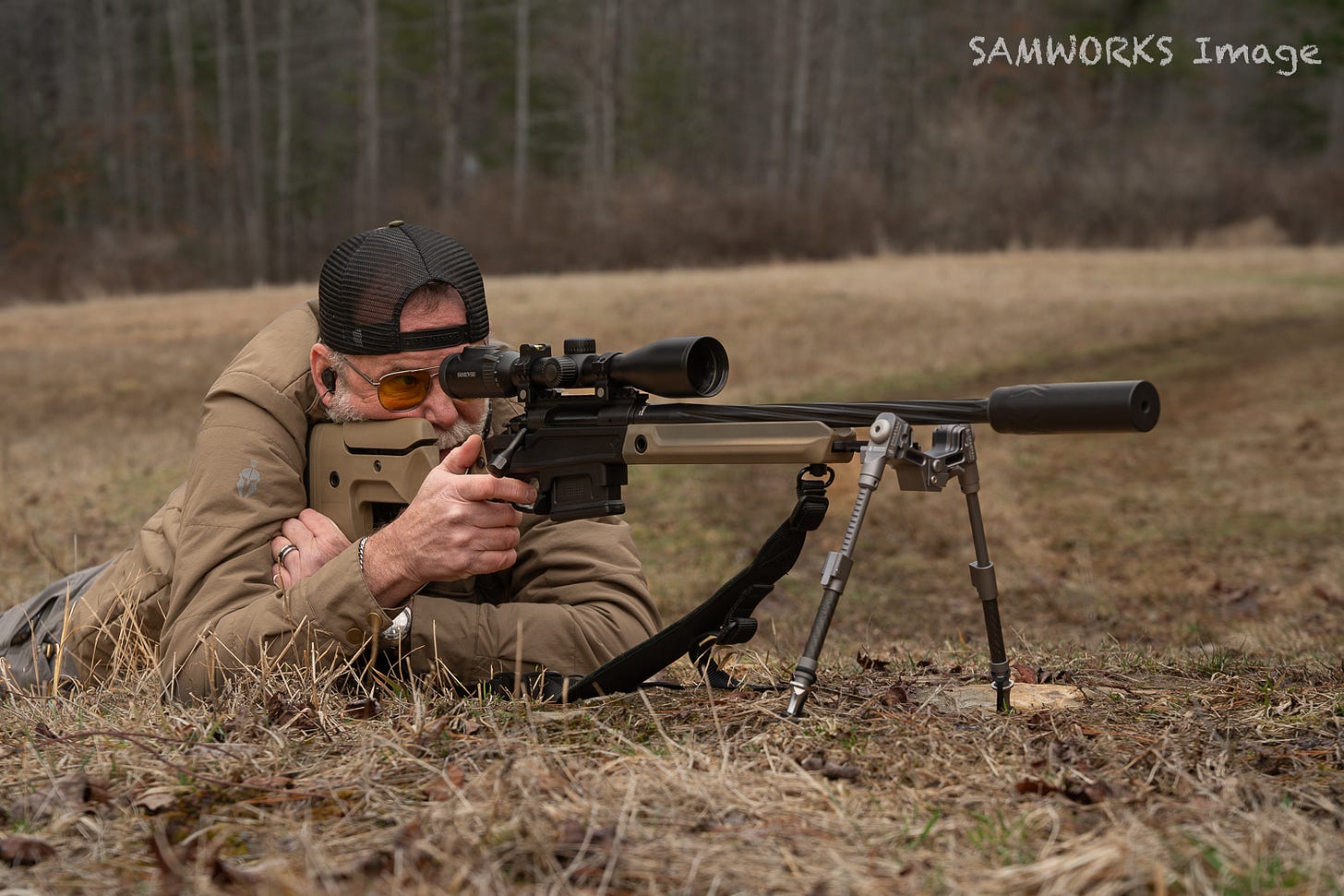Almost everyone who picks up one of my rifles and puts it to their shoulder gets a weird look on their face. They almost always ask me, “Why is your scope mounted so far back.” For a long time, I just looked at these folks wondering why it was a problem. Finally, when I started paying attention to others — when they shot rifles — I realized that almost everyone else did not know how to shoot a rifle. I mount my riflescopes the way I do so I don’t have to stretch my neck out like a turtle to see through them.
I’m sure this will cause some dissention among the ranks of rifle shooters, especially those who shoot a rifle well. The thing is, most of you are doing it wrong. It’s not that you’re doing it in a way that will prevent you from getting hits, you’re doing it unnaturally and in a way that stresses muscles that do not need stressed. When you shoot a rifle you should be as relaxed because unnecessary muscle tension can negatively impact your shooting. Have you ever heard the adage, “if you hold long, you hold wrong,”?

Binoculars and Handguns
Before I describe the correct way to shoot a rifle let me give you some examples or analogies that will help you better understand the process. Let’s start with a binocular. When you look through a binocular you bring the binocular up to your eyes, while your head remains still, and your eyes are looking at what you want magnified. You don’t bring the binocular up to about chin level, holding it out several inches from your body, and then lower your head and stretch your neck out to look through it. This would be, well, stupid.
It's the same with handguns, though many shoot them incorrectly as well. When you’re shooting a handgun you should start – just as with a binocular – by keeping your head still and your eyes on the target. You then bring the handgun up level with your eyes and align the sights with the target. Many handgun shooters only bring the handgun part of the way up to their eyes and then duck down and turtle their neck forward to place their eyes behind the sights. This opposes conservation of motion and basic common sense; it’s easier to move one object into alignment than it is to move two objects into alignment at the same time.
Granted, humans tend to want to move their head closer to something when they want to get a better or serious look at it. We all do it. You’ll pick up a coin and to see it better you’ll turtle your neck out to get your eyes closer. From a practical and logical standpoint, this is sort of stupid as well. It’s much easier to just hold the coin closer to your face.
Now, just imagine you were looking through a binocular, shooting a handgun, or looking at a coin with your head ducked down and your neck turtled out. This puts unnatural stresses on your neck and back and is, well, damned uncomfortable if you do it for any length of time, and being uncomfortable is not conducive to good shooting.
The Stock Problem
Part of the problem with improper rifle shooting technique is the stocks on our rifles. Many shooters assume that all the rifle’s butt pad should be in contact with their shoulder. If this is the way you shoot most rifles you have no choice but to scrunch your head down and turtle your neck out. It wasn’t always this way. Back before riflescopes, most rifle stocks positioned the rifle and sights in front of your eyes with most of the rifle’s buttpad on your shoulder. This is especially true of flint and cap lock muzzleloaders. Those rifles had a tremendous amount of drop in the stock.

But today rifle stocks have less drop so you can get a good check weld that will position your eye behind the riflescope — a riflescope that in many cases is mounted way too high because it is way too big. In some cases, rifle stocks even have negative drop, meaning the heel of the stock is higher than the nose of the comb. This is ideal for establishing a riflescope friendly cheek weld and it also helps the stock slide by your cheekbone during recoil, but if you place a modern day rifle stock on your shoulder so you have contact with all of the butt pad, the only way you can see through the riflescope is to scrunch your head down and turtle your neck.
Let me make a disclaimer here, all necks are not the same, some folks have way too much neck and others barely enough neck. Just to be clear, I’m talking about folks with normal necks.
The stocks on early Weatherby rifles with the high Monte Carlo comb and a lot of drop from the nose of the comb to the heel of the stock solved this problem, but it created another one. The radical drop in the stock enhanced recoil and muzzle flip and it – in conjunction with powerful cartridges – made those rifles uncomfortable to shoot. This is one of the reasons Weatherby rifles gained such a reparation as hard kickers.
The other problem with scrunching your head and turtling your neck is that your eye – pupil – ends up off center. Now we don’t need our pupils centered in our eye sockets to see clearly, but our eyes are more comfortable when they are centered. Just like with riflescopes, you can better achieve optical clarity and optimum performance, the closer the reticle is to the center of the scope tube. You’ve probably noticed this while wearing shooting glasses when you shoot a rifle because you’ve found that you’re looking through the very top of the lens – or maybe even over it – as opposed to through its center. Essentially, your eyes are looking up so you can look straight ahead.

There is another issue with crawling the stock, especially with bolt action rifles. After you fire a shot you should work the action while keeping the stock on your shoulder and disturbing the mount of the rifle as little as possible. This is the best and fastest way to prepare for a follow up shot if it's needed. The closer you position your head to the action, the less room you have to operate the action, because the bolt protrudes to the rear when the action is worked. This is one reason some shooters raise their head from the stock or drop the rifle from their shoulder to cycle the action; they do not want the bolt to poke them in the face.
Unfortunately, there is no such thing as Stock Crawlers Anonymous or a 12 step program to help you overcome this malady. It’s just me and I’m about the only one preaching or offering a cure.
The Right Way
When it comes time to mount a rifle you should keep your head erect and your eyes on target. If you don’t have a target there is no reason to mount the rifle, and if you have a target you should not take your eyes off it. Bring the rifle up and level, or so the barrel is in line with the target, but not so the rifle touches your shoulder. You should also be keeping both eyes open. Now with your eyes on the target pull the rifle back into your shoulder while at the same time raising your shoulder just a bit to maximize its contact with the butt pad of the rifle. With most modern rifle stocks only the bottom half of the butt pad will be in contact with your shoulder.

Now, this is where a lot of folks lose the target. The mistake they make is closing their non aiming eye. You see, you have binocular vision with just a slight bit of parallax. This means that if one eye is looking at the target the other eye is too. Without the aid of mind altering substances we cannot make our eyes look in two different directions. Well, that’s generally the case. I once worked with a man who had a wondering eye and I never knew which one I was supposed to look at when I talked to him. I’m not fully convinced he knew which eye to use most of the time either.
When you’re bringing the rifle back to contact your shoulder the riflescope is blocking your aiming eye’s view of the target. But if your non-aiming eye is looking at the target, your aiming eye is also. What you must learn to do is adjust the positioning of the rifle – riflescope – as you seat the butt pad into your shoulder, so the riflescope is between your aiming eye and the target. Keep your head erect, but tilt it slightly to get your aiming eye over the stock and behind the riflescope. This might seem terribly difficult at first, but with a little practice it starts to come naturally.

NOTE: Just to be clear on keeping your head erect, it does not mean you should be standing perfectly straight. Just as when shooting any firearm, you should obtain what many call a fighting stance – knees over toes, shoulders over knees – with just a slight bit of weight forward to assist with recoil control. What we’re trying to avoid is turtling your neck to obtain a clear view through the rifle scope – adjust the position of the scope not your head.
Now, with the rifle mounted and your aiming eye looking through the riflescope at the target, your head is erect and relaxed. The next thing you need to do is learn to relax the arm that’s connected to your trigger finger. Many rifle shooters squeeze the wrist/grip of the rifle firmly and even pull to help apply butt pad pressure on their shoulder. This is the job of the support hand, not the shooting hand. The job of the shooting hand is to manage the trigger. Your support hand and your shoulder are what support the rifle.
When you execute the mounting of a rifle properly, you’ll very likely discover you mounted your riflescope too far forward for you to see a full and clear view. You’ll need to slide the riflescope back in the rings enough so you can obtain that clear view which is defined as optimal eye relief. I know some of you are already screaming that if you mount your riflescope that far back, recoil will drive it into your forehead. No, it won’t, unless you revert to your old ways of scrunching your head and turtling your neck.
You might also think that if you’re shooting at a steep uphill angle or from prone the scope will smack you in the face. It won’t, if you maintain optimum eye relief. That full and clear view tells you your head is in the correct position. In all my years of shooting rifles I’ve never received the infamous “Weatherby ring” because a riflescope smacked me in the face. It’s easy to avoid – just make sure you’re not crawling the stock to get that full and clear view through the riflescope.
Here’s the thing about getting whacked in the head with the riflescope. With your head turtled forward the muscles in your neck and back are tensed and will maintain that position and tension as the rifle recoils. The proper eye relief is the same no matter how you position your head, but as your body absorbs the recoil your shoulder will move to the rear but your body/brain will subconsciously keep your head in the position you’ve tensed the muscles to maintain. With you head erect and relaxed it will more easily recoil with your body and the rifle.
Don’t just try it, Practice it
Now, you might be thinking, ‘I already shoot a rifle pretty well,’ — and you probably do — ‘so why should I bother.’ The main reason is because if you learn to shoot a rifle as described you can shoot it better because when you shoot, you’re more relaxed. This technique will help you with snap shots because you’ll get on target faster. It will also help you when shooting moving targets because your head and eyes are in their normal – relaxed position – and you can track the target easier.

To learn to do something the correct way is not the same as establishing a subconscious routine that some call muscle memory. The learning phase is just the establishment of neural pathways.
As you practice these movements, synaptic connections – neuron connections – become more efficient. Continued repetition and practice strengthen these connections and your cerebellum refines and coordinates motor patterns to ensure precision and timing. As the skill become more familiar the process transitions from conscious control to the more automatic and subconscious control we call “muscle memory.”
All this takes a lot of time and a lot of repetitions that you refine though proprioception feedback. And all this is a just a very technical way of saying, you must practice a lot and you must continue to practice forever for sustainment.
This is where dry practice is so important and not just dry practice that involves pressing the trigger. Even if you do not believe or trust my thoughts on how to shoot a rifle properly, you should frequently practice assuming whatever shooting position you prefer, so that you can easily, quickly, effectively – and most importantly – at least semi-subconsciously, assume that position.
The great thing about rifle shooting is that if you can get your hits and do it safely, then just do it any damned way you like. Just don’t pick up one of my rifles and wonder what the hell is wrong with my neck or my head or what fool taught me how to shoot. My neck and my head are just fine, and they interface very well – comfortably and relaxed – with my rifles.









The 270 rifle class at Gunsite Academy did wonders for my rifle shooting. This article was a great refresher read. We’ll be doing the Battle Rifle class at Gunsite in November, and I’m sure we’ll be using these techniques.
I read an article recently you wrote in Game and Fish West about the Wilson Combat NULA Model 20. I thought then that you mounted your scope farther back than I do. Ha... now I know why. Thanks!